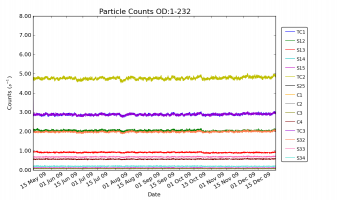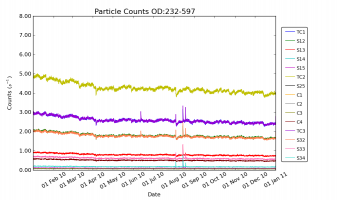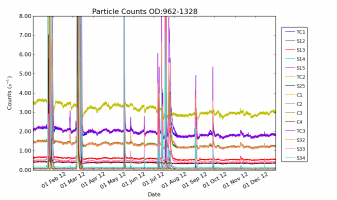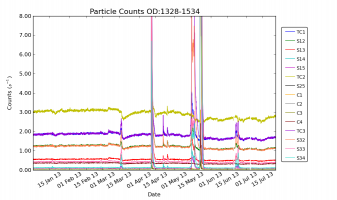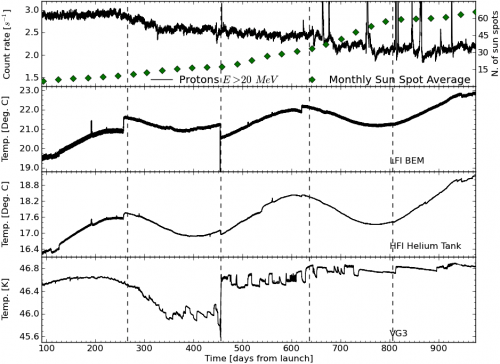Radiation environment
Evolution over the mission[edit]
The Standard Radiation Environment Monitor on board Planck #SREM is a particle detector flown on several ESA satellites. The SREM consists of several detectors sensitive to different energy ranges, which can also be used in coincidence mode. In particular, the SREM measures count rates of high energy protons with E>20 MeV, electrons with E>0.5 MeV and Ions with 150 MeV < E < 185 MeV.
Particle fluxes measured by the SREM on board Planck are shown in the figures below. Each plot in the set below shows the SREM radiation measurements during one full year (except for the first plot showing SREM measurements from launch - May the 14th 2009 - and the last plot with data from January 1st 2013 to October 23rd 2013 - the end of the mission). The plots show all the energy channels available in the SREM.
The radiation environment of Planck is characterised by a start near the minimum in the current solar cycle. As a consequence, the particle flux is dominated by Galactic cosmic rays, rather than by the solar wind. The figure below shows the thermal and radiation environment around Planck during the nominal mission. Vertical lines indicate boundaries between surveys. The top panel shows the cosmic
ray flux as measured by the onboard SREM; its decrease over time is due to the corresponding increase in solar activity, indicated by the sunspot
number, from the Solar Influences Data Centre. Solar flares show up as spikes in the proton flux. The second and third panels show the temperature
variation at two representative locations in the room-temperature SVM, i.e., on one of the (HFI) Helium tanks and on one of the LFI back-end
modules (BEM). The sine-wave modulation tracks the variation of distance from the Sun. The bottom panel shows the temperature evolution of
VG3, the coldest of three so-called V-grooves, to which the sorption cooler is heat-sunk. The disturbances on the curve are due to adjustments of
the operational parameters of this cooler.
The time evolution of the SREM measurements is well correlated with that of identical units flying simultaneously on other satellites (e.g., Herschel, Rosetta) and with indicators of Galactic cosmic rays, and is anti-correlated with solar flare events and with the solar cycle. More importantly for Planck, the SREM measurements are very well correlated with the heat deposition on the coldest stages of the HFI, and with glitch rates measured by the detectors of HFI. A more detailed interpretation of these data is provided in planck2011-1-5.
Notable events[edit]
Apart from the correlation with heat deposition in the coldest stages of the HFI and with HFI glitch rates there were two events seriously disrupting operations:
- On June the 7th 2011 a M-class solar flare between 06:00-07:00 followed by a prompt proton enhancement in the vicinity of the earth caused the HFI to loose control of the bolomoter PID.
The event was characterized by SREM count rates up to 10 times larger than previous days. It led to around 16 hours without bolometer PID control with the temperature of the bolometer plate about 270 above the regulation point, while the Dilution thermal control regulated for some time with only 13 instead of the usual 30 . During about 1 day a significant elevated HFI focal plane temperature was experienced with a peak temp increase on the 100 thermistors about 0.7 .
After the radiation peak on 07/06/11, the bolometer temperature started to decay at a rate of 15-30 . In the evening of 8th of June, HFI was back to nominal.
Besides the thermal effects, the glitch rate increase led to an overproduction of data to be encoded that caused HFI to activate 4 times an automatic function that controls the HFI TM output. This has generated on 07/06/2011 four gaps in the HFI science data that resulted in the loss of around 5 mins of data.
Neither the LFI or the spacecraft subsystems and units were affect by this even.
For some of the SREM channels the particle fluxes did not return to pre event levels before the 17th of June.
- On August the 4th 2011 a M9.3 solar flare was responsible for a substantial increase in the proton flux measured by the SREM. Although the maximum flux was around 50% that of the 7th June flare, this particular event made itself noticeable far longer than any so far. Although the radiation levels only got back to pre event levels around noon on the 6th of August, this was not an oridinary decay and the proton levels where very high until around 01:00 on the 6th of August.
Although the HFI bolometer plate was severly affected thermal control was not lost as in the event of the 7th of June and the peak temperature increase was 170 .
As this event happened during a Jupiter scan and the attitude constraints where adequate, a PSO triggered SGR was raised.
References[edit]
<biblio force=false>
</biblio>
Space Radiation Environment Monitor
European Space Agency
Service Module
(Planck) High Frequency Instrument
(Planck) Low Frequency Instrument
LFI warm electronics Back End Module
Planck Science Office
Small Gap Recovery
